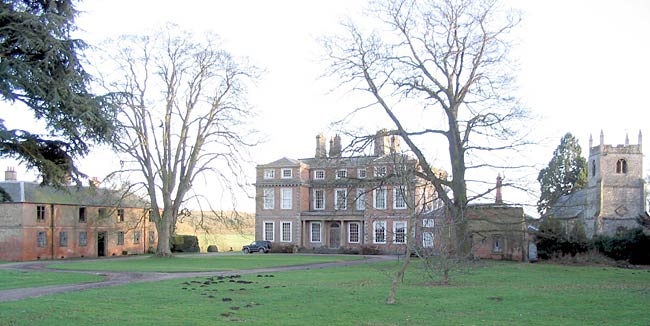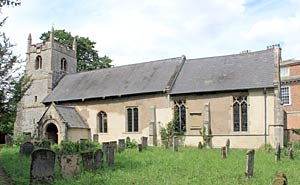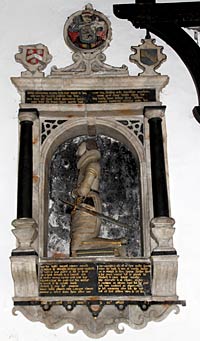< Previous | Contents | Next >
The Great Beech
WINKBURN. One of the county's hidden villages, lying in the valley of the tiny River Wink, it has a few houses and farms, an inn, an ancient church by the great house, and wonderful trees.

Winkburn Hall and the church of St John of Jerusalem (2005).
We see fine groups of almost every kind of tree as we come from Hockerton through the spacious park; and masses of lofty veterans lead from the old gabled schoolhouse to the small church looking very weary of its years. The pride of them all is a magnificent copper beech at one end of the hall; it is one of the largest in the land, 13 feet round its trunk, its great branches touching the ground in a circle of about 90 yards.
Standing at the head of terraced lawn with flights of shallow steps, the hall is chiefly 18th century, with a top storey of the 19th, and some panelling inside belonging to an earlier manor house. Over the doorways in the central hall is a series of panels carved with scenes from Aesop's Fables.

Winkburn church in 2010.
The oldest part of the church is the tower, which is for the most part Norman; the belfry windows are adorned with zigzag and cable moulding, and the Norman archway to the nave is carved all round with heavy zigzag. In an ancient frame of carving with a small figure of a saint, on an outside wall of the tower, is a later stone telling of restoration in the 17th century. One of its three bells of 1633 was lent to Southwell Minster when the bells there were being recast.
A lofty Norman doorway, carved all round with beak-heads, opens to the interior, which is quaint with 17th century furnishing, box-pews, spiral altar rails, a small altar table, a commonplace screen, and a charming three-decker pulpit with a canopy. There is a Jacobean chest, and a decrepit one much older. The font is 17th century. There is bright glass in memory of the Burnells who, after the Dissolution, followed the Knights Hospitallers as lords of the manor.

Monument to William Burnell (1609).
Engraved on his tomb are the arms and portrait of William Burnell of 1570, his features worn away; he was auditor to Henry the Eighth, and brother of Edward Burnell whose fine monument is in Sibthorpe church. William Burnell of 1609 kneels in his wall monument, a lifesize figure in armour, holding a long metal sword; the inscription tells of the marriages he made for his four daughters.
After nine generations at Winkburn, the male line came to an end when Darcy Burnell died in 1774. His initials are on the great lead cistern by the porch, and his elaborate monument has lifesize figures of a bowed woman and an angel holding a plaque with his portrait. His descendants have sold the estate in our time.
